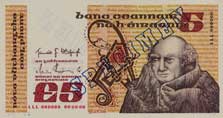
![]()
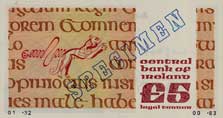
The Central Bank of Ireland Archive, which was first opened to public access in 2017, has provided a lot of new source material on the designs of the Series B banknotes. Some of the content of this article draws from the archive. This is referenced as CBIAR in the text.
The theme of the Scotus Irish five pound note centres around aspects of Irish learning from the 7th to 11th centuries. The overall theme of Series B banknotes is that of Irish Writers, Philosophers and Artists. The new series of notes also had a deliberate Celtic Irish flavour to their design.
In some circles, Ireland's Series B banknotes are referred to as the 'Celtic Design Series'. This is likely due in part to the design of the first two denominations to be issued, the £1 and £5, which had a significantly Celtic feel to them.
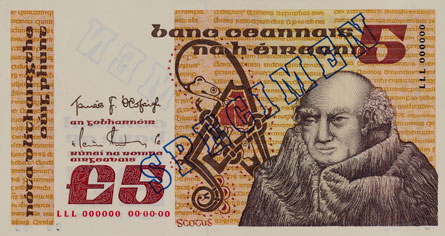
![]()
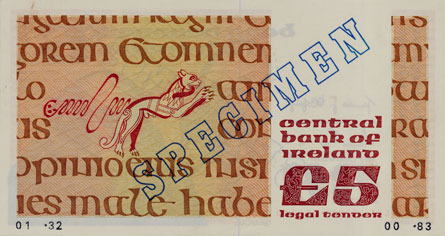
The new Scotus Irish 5 Pound note entered circulation on 1 November 1976, seven months after its first date of issue of 21 February 1976. It was the first denomination of the new Series B banknotes to enter circulation.
The typeface used on the face and reverse of the Scotus five pound note was designed in 1953 by Michael Biggs, sculptor and member of the Servicon team. It was designed as a modern typeface which was based on Unical.
On the face, is the text in Irish 'Banc Ceannais na h-Éireann' (Central Bank of Ireland) 'Nóta dlíthairgthe cúig phunt' (Legal tender note five pounds). In the unprinted field below the watermark are the titles of the signatories, in Irish: 'an gobharnóir' (governor) and 'rúnaí na roinne airgeadais' (secretary of the department of finance).
The reverse text is in English only, 'Central Bank of Ireland' '£5' 'Legal tender'.
The denomination in numerals on both the face and reverse of the Series B Irish 5 pound note are decorated with designs similar to the decorations found in the Book of Kells.
![]()
Detail of the denomination in numerals on the face of the Series B Central bank of Ireland £5 note
![]()
Detail of the denomination in numerals on Series B £5 note reverse
Filling the right hand side of the five pound note is a portrait of John Scotus Eriugena (ca828-878), who was a prominent Irish philosopher [2.].
The symbol in the centre of the note is based on the initial letter A from Psalm 17 in the Psalter of Ricemarcus, which dates from 1064-1082 [3.].
The Ricemarch Psalter and Martryology is a Latin text of Welsh origin written and decorated in the Irish style. It was written about 1079, probably in the scriptorium at Llanbadarn Fawr, Cardiganshire, Wales.
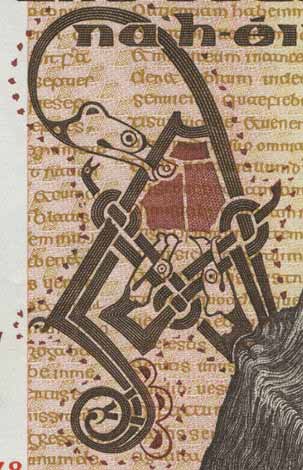
The Symbol in the centre of the Scotus Five Pound note is the initial letter A from Psalm 17 in the Ricemarch Psalter (Psalter of Ricemarcus)
In the background is an extract from the Book of Durrow [4.]. Dating from ca650-700, the book of Durrow is one of the earliest intact books of the gospel surviving in Western Europe. Both works are held in the Library of Trinity college, Dublin.
A design based on an extract from the Book of Kells is on the reverse of the Scotus Irish 5 pound note. The Book of Kells dates from ca800 and is on display in the Library of Trinity College, Dublin [5.].
The dimensions of the book of Kells are 33 x 25 cm. Its pages are made of vellum which are decorated with painted images. It is written in Latin text in insular script in a variety of ink colors. The book of Kells contains the complete gospels of Matthew, Mark, and Luke, and part of the gospel of John, along with cross-references, summaries, commentary and indexes [6.].
The reverse of the Series B 5 pound note is based on page 40 of the Book of Kells. In the Book of Kells, the original drawing of the lion measures 46 x 23 mm approximately.
On the Irish 5 pound note, the lion measures 60 x 30 mm, nearly half as large as the original. The lion on the reverse of the Series B five pound note is a very close reproduction of the oigonal. The text around the lion has been rearranged, the effect of which allows more prominence to the lion image on the banknote. The text leading has been reduced and the lion occupies two lines of text rather than the one line in the Book of Kells.
The original page 40 of the Book of Kells on which the reverse design of the Scotus 5 pound note is based is designated by trinity College Library as Folio 40r: Matthew Shelf Mark/Reference Number: IE TCD MS 58. A Direct link to the Book of Kells page 40 is available on the Trinity college website [7.].
The Irish Scotus Five Pound note was a radical design change from the Series A 'Lady Lavery' Five Pound legal tender note which it replaced. The old Series A banknotes had been in circulation since September 1928.
The new Irish 5 Pound note was somewhat of a shock to the public when it was first released in 1976. It was a radical design departure from the well-established 'Lady Lavery' banknotes.
The Series B £5 note is only slightly smaller in size than the Series A £5 note it replaced. Dimensions of Irish pound notes tended to vary by a millimetre or so. The dimensions below are from measurements of actual notes.
Series A, Lady Lavery 5 Pound Note, 165 x 92 mm.
Series B, Scotus 5 Pound Note, 156 x 82 mm.
Below, illustrated are the final date of Series A Central Bank of ireland 5 pound notes, and the first date of Series B Irish 5 pound notes.
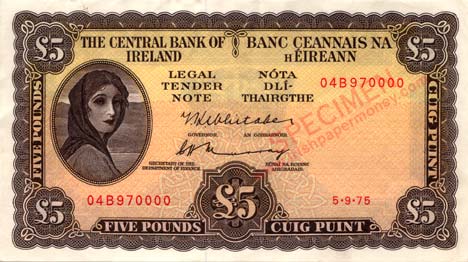
![]()
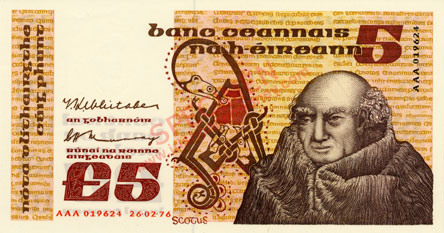
The Series B banknotes became known as the 'Irish Punt series', more abroad than in Ireland, due likely to their being printed only in Irish on the face. The 'Five Punt', John Scotus Eriugena was a very common denomination, and examples of the note are easy to obtain up to AU grade, especially the final date of issue which was kept in large quantities.
The first date is the scarcest by signature, as there was only one date of issue with less than a full set of prefixes printed. However, it is available in strict UNC as examples were carefully sought out and kept by banknote collectors at the time. This first date note is also significant in that it is the only Series B banknote which bears the signature of Dr. T. K. Whitaker.
Face, primarily brown on orange and yellow underprint. The overall colour is not unlike that of the old Series A £5 note that the Scotus 5 pound replaced.
All notes bear a date of issue in red ink. Each date is tied to a specific group of prefixes based on the twelve letters A-L. When those prefixes are used up, the date is changed for the next group of prefixes
Metallic Thread: A metal security runs vertically through the middle of the note, embedded in the paper. This was a common security feature used in banknote production at the time.
The central area of the face of each banknote features a strip several cntimetres wide which flouresces under UV light running from top to bottom of the note.
The John Scotus Five Pound note was the first denomination of the Series B banknotes to enter circulation. It had the longest period of circulation of any of the Series B banknotes, circulating for 18 years.
The Scotus £5 note was withdrawn from circulation in 1994, to be replaced by the new Series C £5 note, first issued on 15 April 1994.
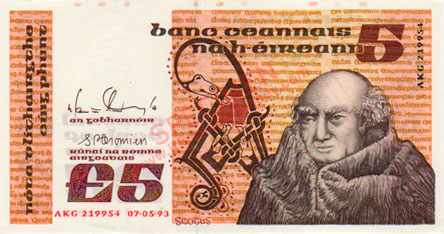
![]()
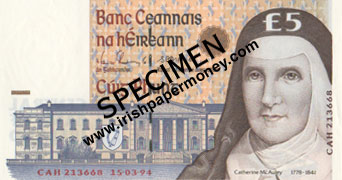
E140. Type 15: Signatures: T. K. Whitaker, C. H. Murray. 1 Date, 1 replacement AAA. 26.02.76.
E141. Type 16: Signatures: C. H. Murray, M. O Murchú. 5 Dates, 2 replacements AAA. 18.05.76-17.10.77.
E142. Type 17: Signatures: C. H. Murray, Tomás F. Ó Cofaigh. 9 Dates, 5 replacements AAA, FFF. 25.04.79–29.10.81.
E143. Type 18: Signatures: Tomás F. Ó Cofaigh, Maurice Doyle. 7 Dates, 5 replacements, AAA, 17.10.83-22.04.87.
E144. Type 19: Signatures: Maurice Doyle, S. P. Cromien. 14 Dates, 3 replacements, AAA, FFF. 12.08.88-07.05.93.

![]()

![]()
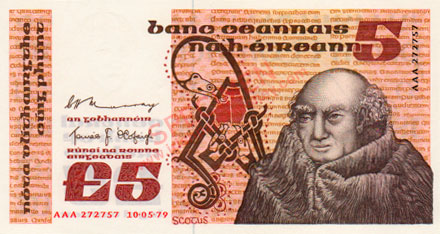
![]()

![]()

The five signature varieties of the Scotus Series B Five Pound notes
There were 36 dates of issue for the Series B £5 note. The first date issued was 26.02.76, and the final date was 07.05.93.
The John Scotus Eriugena five pound notes are common, and it is straightforward to collect all the dates of issue at little expense. An image of each of the 36 dates of issue can be viewed on the Series B Five Pound Note Dates page.
Scotus Five Pound notes used a prefix of three letters the same as replacement note identifiers, a system used on all Irish replacement notes of Series B and Series C. Throughout the lifetime of Series B, the Scotus 5 pound notes used letters AAA, and FFF in that order.
AAA was used on dates 26.02.76 through to 29.09.89. FFF was used on dates from 21.11.89 to 12.07.91. There are instances of FFF used on an earlier date, 12.10.81. These notes have been marked up as Specimens.
The Irish Replacement Notes List is kept up to date with information on sightings of Scotus 5 pound replacement notes. There is a full listing of recorded serial number brackets for each replacement note date of all denominations. An image of every date recorded for Series B replacement notes can be viewed in the Series B View By Date pages.
References [Last retrieved 24.08.24]
1. Central Bank of Ireland Archives, Dublin. Referred to as CBIAR in the text. [Accessed 24 May 2018].
2. John Scotus Eriugena (ca828-878) <https://www.britannica.com/biography/John-Scotus-Erigena><https://plato.stanford.edu/entries/scottus-eriugena/>
3. Psalter of Ricemarcus (1064-1082) <https://www.tcd.ie/library/manuscripts/blog/2013/03/the-ricemarch-psalter-an-irishwelsh-manuscript>
4. The Book of Durrow, Trinity College Dublin. TCD MS 57 <https://www.tcd.ie/library/exhibitions/directors-choice/durrow/>< https://digitalcollections.tcd.ie/concern/works/wm117t53k?locale=en&page=4 >
5. The Book of Kells. <https://www.tcd.ie/library/research-collections/book-of-kells.php ][ https://www.worldhistory.org/Book_of_Kells>
6. About The Book of Kells. <https://www.khanacademy.org/humanities/medieval-world/early-medieval-art/x4b0eb531:ireland/v/the-book-of-kells>
7. Book of Kells, page 40. <https://digitalcollections.tcd.ie/concern/folios/jw827b869?locale=en>
Background Reading
1. Ricemarch Psalter. <https://digitalcollections.tcd.ie/concern/works/2801pk516?locale=en>
A copy of the Ricemarch Psalter can be downloaded in pdf format <https://openlibrary.org/books/OL24781564M/The_Psalter_and_martyrology_of_Ricemarch>
<https://ia800509.us.archive.org/24/items/psaltermartyrolo02lawl/psaltermartyrolo02lawl.pdf>
2. The Book of Kells.
<https://www.bbc.com/culture/article/20160425-the-book-of-kells-medieval-europes-greatest-treasure
1 Pound Ploughman
5 Pounds Ploughman
10 Pounds Ploughman
20 Pounds Ploughman
50 Pounds Ploughman
100 Pounds Ploughman
Irish Ten Shilling Notes
1 Pound Note Lady Lavery
5 Pounds Lady Lavery
10 Pounds Lady Lavery
20 Pounds Lady Lavery
50 Pounds Lady Lavery
100 Pounds Lady Lavery
1 Pound Note, Queen Medb
5 Pound Note, John Scotus Eriugena
10 Pound Note, Jonathan Swift
20 Pound Note, W. B. Yeats
50 Pound Note, Turlough O'Carolan
100 Pound Note, Grace O'Malley
5 Pound Note, Sister Catherine McAuley
10 Pound Note, James Joyce
20 Pound Note, Daniel O'Connell
50 Pound Note, Douglas Hyde
100 Pound Note, Charles Stewart Parnell
Northen Ireland Polymer notes
Bank of Ireland Polymer Notes
Danske Bank Polymer Notes
Ulster Bank Polymer Notes
Special Sections and Articles
The Transition of Irish Currency, Irish banknotes 1918–1928
The Partition of Irish Currency, Irish banknotes 1928–1930
Banknote Design Evolution 1824 to 1916
Irish Three Pound Notes
Contemporary Forgeries of Early Irish Banknotes, ca1800-1930
Limerick Soviet Notes
Irish World War 2 Banknote Issues
Low Number Irish Banknotes
Irish Joint Stock Banks of Note Issue from 1783
Irish Legal Tender Note Specimens
Ploughman Scan Survey (PSS)
![]()
![]() Stable version. Additions pending. Last update 08.12.24.
Stable version. Additions pending. Last update 08.12.24.